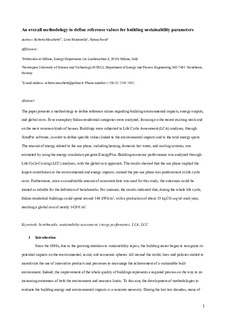An overall methodology to define reference values for building sustainability parameters
| dc.contributor.author | Moschetti, Roberta | |
| dc.contributor.author | Mazzarella, Livio | |
| dc.contributor.author | Nord, Natasa | |
| dc.date.accessioned | 2019-01-21T12:29:38Z | |
| dc.date.available | 2019-01-21T12:29:38Z | |
| dc.date.created | 2015-01-05T10:21:35Z | |
| dc.date.issued | 2015 | |
| dc.identifier.citation | Energy and Buildings. 2015, 88 413-427. | nb_NO |
| dc.identifier.issn | 0378-7788 | |
| dc.identifier.uri | http://hdl.handle.net/11250/2581527 | |
| dc.description.abstract | The paper presents a methodology to define reference values regarding building environmental impacts, energy outputs, and global costs. Four exemplary Italian residential categories were analyzed, focusing on the recent existing stock and on the most common kinds of houses. Buildings were subjected to life cycle assessment (LCA) analyses, through SimaPro software, in order to define specific values linked to the environmental outputs and to the total energy spent. The amount of energy related to the use phase, including heating, domestic hot water, and cooling systems, was estimated by using the energy simulation program EnergyPlus. Building economic performance was analyzed through life cycle costing (LCC) analyses, with the global cost approach. The results showed that the use phase implied the largest contribution to the environmental and energy impacts; instead the pre-use phase was predominant in life cycle costs. Furthermore, since a considerable amount of consistent data was used for this study, the outcomes could be treated as reliable for the definition of benchmarks. For instance, the results indicated that, during the whole life cycle, Italian residential buildings could spend around 140 KWh/m2, with a production of about 35 kg CO2 eq/m2 each year, reaching a global cost of nearly 1,420 €/m2. | nb_NO |
| dc.language.iso | eng | nb_NO |
| dc.publisher | Elsevier | nb_NO |
| dc.rights | Attribution-NonCommercial-NoDerivatives 4.0 Internasjonal | * |
| dc.rights.uri | http://creativecommons.org/licenses/by-nc-nd/4.0/deed.no | * |
| dc.title | An overall methodology to define reference values for building sustainability parameters | nb_NO |
| dc.type | Journal article | nb_NO |
| dc.type | Peer reviewed | nb_NO |
| dc.description.version | acceptedVersion | nb_NO |
| dc.source.pagenumber | 413-427 | nb_NO |
| dc.source.volume | 88 | nb_NO |
| dc.source.journal | Energy and Buildings | nb_NO |
| dc.identifier.doi | 10.1016/j.enbuild.2014.11.071 | |
| dc.identifier.cristin | 1190257 | |
| dc.description.localcode | © 2015. This is the authors’ accepted and refereed manuscript to the article. This manuscript version is made available under the CC-BY-NC-ND 4.0 license http://creativecommons.org/licenses/by-nc-nd/4.0/ | nb_NO |
| cristin.unitcode | 194,64,25,0 | |
| cristin.unitname | Institutt for energi- og prosessteknikk | |
| cristin.ispublished | true | |
| cristin.fulltext | postprint | |
| cristin.qualitycode | 2 |

